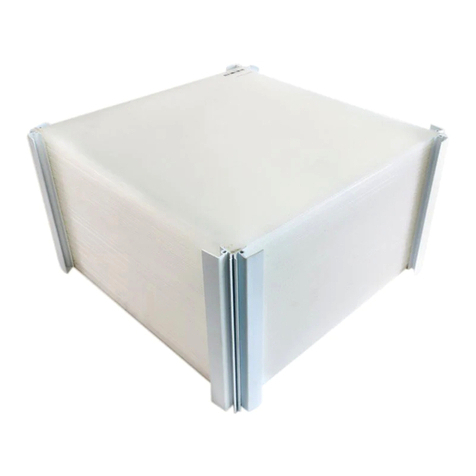2. Odour due to downtime / storage
a. Smells Musty to "chemical"
b. Evaporates after a few days of ventilation
c. Action: Set the ventilation device to the
highest air exchange rate when you are not
at home and repeat the process until the
odour evaporates.
3. Odour transmission (Exchange of odours in the air
currents via the membrane)
a. Smell depending on the smell transmitted
and smells from outside or from other
rooms (very critical onions and garlic,
smoke? Tar?)
b. Evaporates after a few days of ventilation
c. Action: Set the ventilation device to the
highest air exchange rate when you are not
at home and repeat the process until the
odour evaporates. (We recommend an
extractor hood, especially if there are
kitchen smells!)
•
4. Odour due to unknown influences / damage
a. Odour undetermined (source unknown)
b. Builds up more and more over time and
does not dissipate after a few days or
weeks.
c. Please contact your service technician. You
can check a number of parameters yourself
in advance: checking the device settings,
air distribution and filter systems.
In addition to odours from the inside, odours from the outside
can also get into the interior via the ventilation system. These
odours can be "picked up" by the ERV and linger for a long
time.
With the products HRV and ERV there can be a small amount
of odour transmission due to air exchange through leakage.
However, this exchange takes place to such a small extent
that only substances with a very low odour threshold can be
perceived.
The risk of odour transmission is slightly higher with ERV
because, in addition to leakage, transmission via the
membrane cannot be 100% ruled out. The membranes we
use are technically of a very high standard and very selective
with regard to water molecules. This makes it difficult for
other molecules, e.g. VOC (volatile organic compounds), to
pass through the membrane.
Measurements show that, depending on the chemical
substance class and molecular size, organic compounds up
to 99% are blocked by the membrane.
Notes radioactive noble gas radon
When uranium and radium are present in varying degrees in
all soils and rocks decay, radon is produced, which spreads
through the soil and finally reaches the earth's surface.
Radon also reaches the interior of houses from the subsoil
of buildings, where it can accumulate. This can lead to high
radon concentrations, which are hazardous to health,
especially if the room is not ventilated very often.
Radon concentrations in the soil, in the air and indoors vary
locally and regionally.
The membrane of the ERV is permeable to air and thus also
to noble gases such as radon to a certain extent. However,
due to the membrane permeability, the exchange of radon
from supply and exhaust air is far below the exchange of air-
air due to the average leakage of an ERV or the ventilation
system itself.
By using a ventilation system in general, you ensure that
more fresh air gets into the interior and that accumulation
with radon, which can lead to a health hazard, can be
prevented. All of this is independent of whether you run an
ERV or an HRV in your ventilation system.
Notes Use on ships, coastal areas and islands
The ERV is a component for energy recovery (recuperation)
for ventilation units designed for living spaces. However, the
composition of the airflows has a strong influence on the
aging of the ERV.























